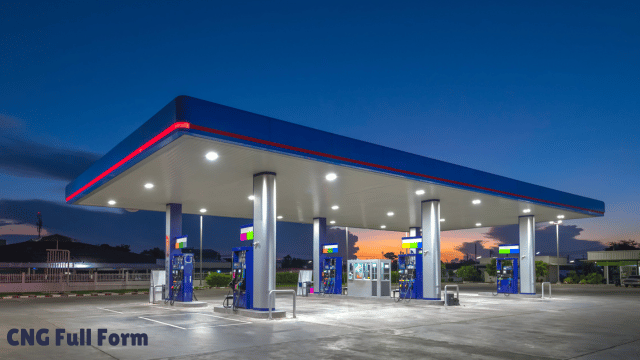In today’s world, where the demand for cleaner and more efficient energy sources is rapidly increasing, CNG has emerged as a popular alternative to traditional fossil fuels. Whether you’re a car owner considering a fuel switch or someone interested in sustainable energy solutions, understanding what CNG is and its significance is crucial. This guide will take you through the full form of CNG, its benefits, applications, and much more.
What is CNG?
Full Form of CNG
CNG stands for Compressed Natural Gas. It is natural gas that has been compressed to a high pressure, reducing its volume for easier storage and transportation. CNG is primarily composed of methane (CH4), a hydrocarbon that is known for its clean-burning properties.
Composition of CNG
The primary ingredient of CNG is methane, which typically makes up about 70-90% of the gas. Alongside methane, CNG may contain small amounts of other hydrocarbons such as ethane, propane, and butane, as well as trace elements like carbon dioxide, nitrogen, and water vapor. The high methane content is what makes CNG a cleaner alternative to other fossil fuels.
Why is CNG Important?
Environmental Significance
One of the most compelling reasons for the growing popularity of CNG is its environmental benefits. When burned, CNG produces fewer harmful emissions compared to gasoline or diesel. Specifically, CNG emits lower levels of carbon monoxide, carbon dioxide, nitrogen oxides, and particulate matter, contributing to reduced air pollution and a decrease in greenhouse gas emissions.
Economic Advantages
CNG is often more affordable than gasoline or diesel, offering a cost-effective alternative for both individuals and businesses. The lower cost of CNG is due in part to the abundance of natural gas reserves and the simplicity of the compression and distribution process. Furthermore, vehicles running on CNG generally have lower maintenance costs, as the fuel burns cleaner and causes less engine wear.
Energy Security
For countries with large natural gas reserves, such as the United States, Russia, and Iran, CNG presents an opportunity to enhance energy security. By utilizing domestically produced natural gas, these nations can reduce their dependence on imported oil and bolster their energy independence.
Applications of CNG
Transportation
CNG is widely used in the transportation sector, particularly in public transport systems such as buses, taxis, and delivery vehicles. The switch to CNG in transportation is driven by both environmental and economic incentives. Vehicles powered by CNG produce fewer emissions, and the fuel is often cheaper than conventional options, leading to long-term savings.
Power Generation
CNG is also utilized in power generation, especially in regions with an abundant supply of natural gas. It can be used to fuel gas turbines and engines in power plants, providing a cleaner alternative to coal and oil. The use of CNG in power generation helps in reducing greenhouse gas emissions and other pollutants, thereby contributing to a cleaner environment.
Industrial Applications
Industries that require high-temperature processes, such as those involved in glass manufacturing, metal processing, and ceramics, often use CNG as an energy source. The clean-burning properties of CNG make it an ideal fuel for these industries, helping them to comply with environmental regulations and reduce their overall carbon footprint.
How is CNG Produced and Distributed?
Extraction of Natural Gas
The production of CNG begins with the extraction of natural gas from underground reservoirs. Natural gas is often found alongside oil deposits or in natural gas fields. Once extracted, the gas undergoes processing to remove impurities and separate it into its component gases.
Compression Process
After processing, the natural gas is compressed to a high pressure, typically between 3,000 and 3,600 pounds per square inch (psi). This compression process reduces the gas’s volume, making it easier to store and transport. The compressed gas is then stored in high-pressure tanks, ready for distribution.
Distribution and Refueling
CNG is distributed through a network of pipelines and refueling stations. Many countries are expanding their infrastructure to support CNG, making it more accessible to consumers. Vehicles that run on CNG are equipped with specialized tanks designed to store the compressed gas safely. During refueling, the CNG is transferred from the station’s storage tanks to the vehicle’s fuel tank.
Advantages of Using CNG
Environmental Benefits
CNG is recognized for its environmental benefits, as it burns cleaner than gasoline or diesel. The lower emissions of carbon monoxide, nitrogen oxides, and particulate matter result in better air quality and a reduction in health risks associated with pollution. Moreover, CNG emits less carbon dioxide, making it a more environmentally friendly option that helps mitigate the effects of climate change.
Economic Benefits
One of the main advantages of CNG is its cost-effectiveness. CNG is generally less expensive than gasoline or diesel, leading to significant savings for consumers, particularly those who drive frequently or operate commercial vehicles. Additionally, because CNG burns cleaner, vehicles powered by it require less frequent maintenance, further reducing operating costs.
Safety Advantages
CNG is considered a safer fuel compared to gasoline or diesel. Natural gas is lighter than air, so in the event of a leak, it dissipates quickly, reducing the risk of fire or explosion. Furthermore, CNG has a higher ignition temperature than gasoline or diesel, making it less likely to ignite accidentally.
Challenges of CNG
Infrastructure Development
One of the primary challenges facing the widespread adoption of CNG is the development of infrastructure. While CNG refueling stations are becoming more common, they are still less prevalent than gasoline stations. This limited availability can make it challenging for consumers, especially in rural or remote areas, to access CNG.
Vehicle Conversion Costs
Converting a vehicle to run on CNG can be costly. The conversion process involves installing a CNG fuel system, which includes high-pressure tanks, regulators, and injectors. Although the long-term savings on fuel and maintenance can offset the initial conversion cost, the upfront expense can be a barrier for some consumers.
Limited Driving Range
CNG-powered vehicles typically have a shorter driving range compared to those powered by gasoline or diesel. This is because natural gas has a lower energy density, meaning that a CNG tank must be larger to provide the same amount of energy as a gasoline tank. Although advancements in CNG storage technology are helping to address this issue, the limited range remains a drawback for long-distance driving.
The Future of CNG
Technological Innovations
Technological advancements are expected to play a significant role in the future of CNG. Researchers are exploring new materials and designs for CNG tanks that could increase their capacity while reducing weight. Additionally, improvements in compression and distribution technologies could help expand CNG’s infrastructure, making it more accessible to a broader audience.
Policy Support and Incentives
Government policies and incentives will be crucial in promoting the adoption of CNG. Many countries have implemented tax breaks, subsidies, and other incentives to encourage the use of CNG in transportation and industry. These measures can help offset the costs of vehicle conversion and infrastructure development, making CNG a more attractive option for consumers and businesses.
Integration with Renewable Energy
The integration of CNG with renewable energy sources, such as biogas, offers an exciting opportunity for the future. Biogas, produced from organic waste through anaerobic digestion, can be upgraded to a quality similar to natural gas. When combined with CNG, biogas can provide a renewable and sustainable energy source, further reducing the environmental impact of natural gas usage.
FAQs About CNG
1. What is the full form of CNG?
CNG stands for Compressed Natural Gas. It is a type of natural gas that has been compressed to a high pressure for easier storage and transportation.
2. How is CNG different from LPG?
CNG (Compressed Natural Gas) and LPG (Liquefied Petroleum Gas) are both alternative fuels, but they differ in composition and usage. CNG is primarily composed of methane, while LPG is a mixture of propane and butane. CNG is stored at high pressure as a gas, whereas LPG is stored as a liquid at lower pressure. CNG is commonly used in transportation, while LPG is often used for cooking and heating.
3. What are the benefits of using CNG over gasoline?
CNG offers several benefits over gasoline, including lower emissions of pollutants, reduced fuel costs, and improved engine life due to its cleaner-burning properties. Additionally, CNG is safer to use, as it is less likely to ignite accidentally and dissipates quickly in the event of a leak.
4. Can I convert my gasoline vehicle to run on CNG?
Yes, most gasoline vehicles can be converted to run on CNG. However, the conversion process can be costly and requires the installation of specialized equipment, such as high-pressure tanks and fuel injectors. It’s essential to have the conversion done by a certified professional to ensure safety and compliance with regulations.
5. Is CNG a renewable energy source?
CNG itself is not a renewable energy source, as it is derived from natural gas, a fossil fuel. However, when combined with biogas, a renewable energy source produced from organic waste, CNG can contribute to a more sustainable and environmentally friendly energy system.
Conclusion
CNG, or Compressed Natural Gas, represents a critical step toward a more sustainable and eco-friendly energy future. With its lower emissions, cost-effectiveness, and safety advantages, CNG is becoming an increasingly popular alternative to traditional fossil fuels. While challenges such as infrastructure development and vehicle conversion costs exist, ongoing technological advancements and supportive government policies are paving the way for broader adoption of CNG as a key energy source.












